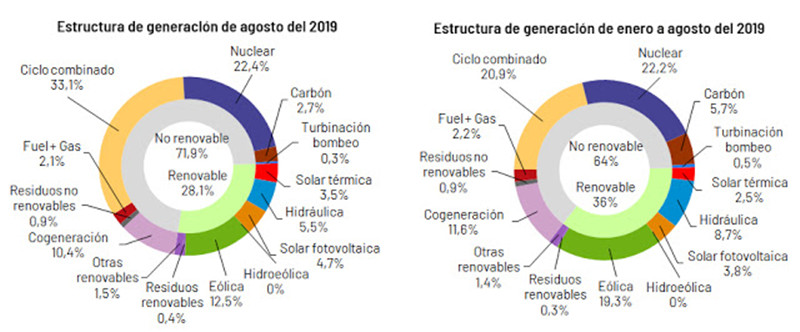Wind energy accounted for 19.3% of electricity until August in Spain. In August, 28.1% of the Spanish generation was renewable energy, wind power 12.5%, concentrating solar thermal 3.5% and photovoltaic 4.7%, and more than half did not emit CO2 into the atmosphere. In the first eight months of the year, renewables reach 36% of the total generation: wind power 19.3%, concentrated solar power 2.5% and photovoltaic 3.8%.
The demand for national electricity in August is estimated at 22,883 GWh, 2.7% lower than that registered in the same month of the previous year. If the effects of the calendar and temperatures are taken into account, the figure drops 3.8% compared to August 2018.
0831_Generacion_agosto_y_enero_agosto2019nacional_1_副本.jpg
In the first eight months of 2019, demand is estimated at 177,896 GWh, 1.6% less than in 2018. Again, once the influence of the calendar and temperatures has been corrected, demand is 2.6% lower to the one registered in the same period of the previous year.
In the month of August and according to estimated data today, the generation from renewable energy sources accounted for 28.1% of production. In the first eight months, renewable generation reaches 36% of the total electricity balance.
In this month of August, 50.8% of electricity production came from technologies that do not emit CO2.
With information available today, wind production in August reached 2,831 GWh, 9.6% lower than the same period last year, and accounted for 12.5% of national production.
The demand for electrical energy drops 2.9% in the peninsular electrical system
In the peninsular electricity system, the demand for August is estimated at 21,354 GWh, 2.9% lower than that registered in the same month of the previous year. If the effects of the calendar and temperatures are taken into account, the figure drops 4.2% compared to August 2018.
In the first eight months of 2019, the demand for electricity in the Peninsula is estimated at 167,550 GWh, 1.7% less than in 2018. Again, once the influence of the calendar and temperatures has been corrected, the demand is 2.7% lower than that registered in the same period of the previous year.
During this month and according to estimated data today, 28.8% of the peninsular generation was of renewable origin and 53% came from technologies that do not emit CO2. For its part, the wind registered 2,672 GWh, 12.9% lower than in August last year, and contributed 12.5% to the mix.
The demand for electricity increases in the Balearic Islands and falls in the Canary Islands in the month of August
In the Balearic Islands, the demand for electricity in August is estimated at 708,096 MWh, 0.6% higher than that registered in the same month of the previous year. If the effects of the calendar and temperatures are taken into account, the figure increases 2.4% compared to August 2018. In the first eight months of 2019, the Balearic demand is estimated at 4,211,659 MWh, a 0, 6% more than in 2018.
Coal, with 48.5% of the total, was the first source of electricity generation in the Balearic Islands, where renewable technologies that do not emit CO2 accounted for 4.8%.
On the other hand, in the Canarian archipelago the demand for electricity is estimated at 779,450 MWh, 0.4% lower than that registered in August 2018. If the effects of the calendar and temperatures are taken into account, the figure drops by 1 % with respect to the same month of the previous year. From January to August, demand in the Canary Islands is estimated at 5,855,324 MWh and increases 0.3% compared to the same period of the previous year.
In the month of August and according to estimated data, the combined cycle was the leading technology in the Canarian generation mix, with a contribution of 37.3%. Renewables and emission-free technologies accounted for 23.2% of the Canarian generation.
